See a profile of this species from our partner. (Note: Jumps to offsite partner content.)
Can Displace Native Plants, Animals
This plant, resembling miniature water lilies, disrupts sensitive habitats.


See a profile of this species from our partner. (Note: Jumps to offsite partner content.)
Can Displace Native Plants, Animals
This plant, resembling miniature water lilies, disrupts sensitive habitats.
See profiles of this species from our partners. (Note: Jumps to offsite partner content.)
Reed mannagrass can form dense stands that crowd out native wetland vegetation. Invasive.org, USDA Forest Service.
Moderate Impact in Great Lakes
Reed mannagrass has a moderate environmental impact in the Great Lakes. A technical profile. US Geological Survey.
Grows and Spreads Aggressively
A brief profile. US Geological Survey.
See profiles of this species from our partners. (Note: Jumps to offsite partner content.)
Glossy buckthorns grow into dense thickets, displacing native under-story plants, shading tree seedlings, and lead to decreased insect diversity. Western New York Partnership for Regional Invasive Species Management.
Buckthorn species are very aggressive and produce dense thickets that shade out native species. St. Lawrence-Eastern Lake Ontario Partnership for Regional Invasive Species Management.
Severe infestations of buckthorns may limit the regeneration of native tree seedlings. Adirondack Park Invasive Plant Program.
Biology | | Impacts | Detection | Management
The spotted lanternfly, Lycorma delicatula, is an invasive species to the United States, first discovered in Pennsylvania in 2014. It was originally from China and southern Asian countries such as India. It is likely to become a serious agricultural pest without natural enemies to keep populations low. It was accidentally introduced into South Korea in 2006 and has spread dramatically to become a major agricultural pest, especially for grape production.
The risk of spread in the northern US was once believed to be low due to cold winters. More recently, however, many eggs and newly hatched nymphs have survived the winter. While not yet in New York, the spotted lanternfly is on the border with Pennsylvania and if it does move into NY and become established, it has the potential to become a significant agricultural pest causing untold physical and economic damage.
.jpg)
.jpg)
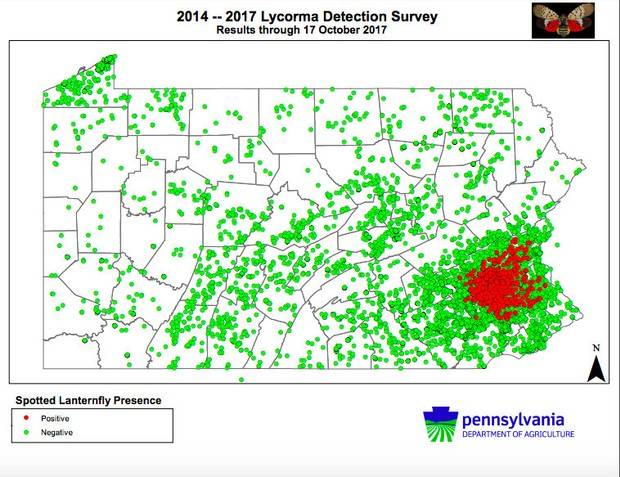
Spotted lanternfly eggs hatch as nymphs in April and May during the early hours of the day. The black bodied nymphs go through 4 growth phases (instars) before becoming a winged adult. Instars 1-3 have white spotted black bodies, while the 4th instar develops black and red mottling under the white spots. Adult lanternflies have grayish forewings with black spots; the hind wings are red and black spotted on the lower portion and grey and black with a bold white stripe on the upper portion. Adult females are about an inch in length; males are about 4/5ths of an inch. Adults are strong hoppers but weak fliers. In the fall, adults often shift to feeding the invasive Tree of Heaven (Ailanthus altissima). In late September until early winter, adults lay oothecas, or egg sacs, which house up to 30-50 brown seedlike eggs with a shiny, light orange/brown waxy coating. The egg sacs have a smooth, shiny surface. While lanternflies often lay eggs on Tree of Heaven, they will use any smooth, vertical surface including other smooth-barked trees, stones, vehicles, outdoor furniture and other manmade surfaces. Eggs in Pennsylvania overwintered successfully in 2014; once eggs hatch the waxy coating is removed, leaving parallel lines of hatched egg sacs behind.
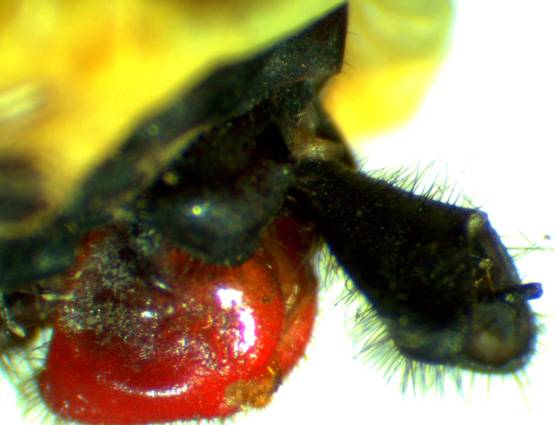
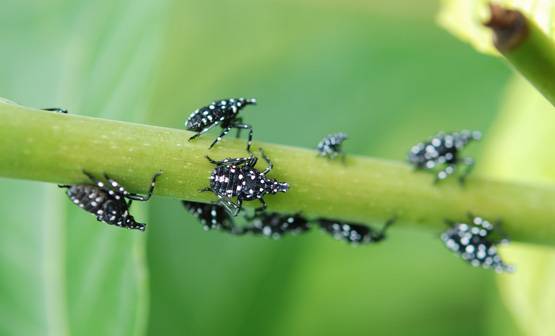
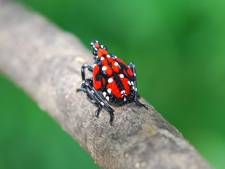
Both adults and nymphs use their piercing and sucking mouthparts to eat the phloem tissue of a wide variety of plants in order to obtain nutrients. The insects also excrete a sugary fluid similar to aphid honeydew, which encourages mold and disease growth. In the native range of the spotted lanternfly, these impacts does not normally kill host plants; absence of natural predators, however, can lead to overinfestaton and cause sickness and death in infested plants. Overfeeding by the lanternflies can extract a damaging percentage of the plant’s nutrients, and the dripping sap from lanternfly feeding wounds combined with sugary lanternfly excretia can lead to mold and disease damage.
Spotted lanternflies feed on over 65 species of plants, preferring plants that have high sugar content and toxic metabolites. These include many agricultural species such as fruit vines (grapes), fruit trees (apples, cherries, peaches, pears, plums) and maple trees. Ornamental plants and forestry species including dogwoods, lilacs and pines are also susceptible. The spotted lanternfly has the potential to become a serious agricultural pest and stressor on natural systems.
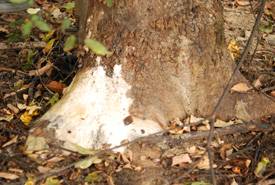
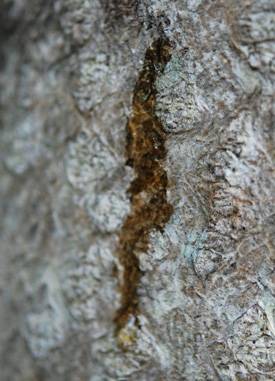
In the spring, look for the white-spotted black-bodied nymphs and white-spotted, mottled red-and-black fourth instar nymphs feeding on any of the wide variety of host species, both woody and non-woody. In the summer, adults are visible while feeding. Indicators of lanternfly damage are seeping sap wounds on non-woody and woody species, and patches of blackened soil around the plant base. Other insects and molds are also attracted by the sugary secretions caused by the sap and honey dew, including ants, bees and wasps. In the fall, brownish egg sacs can be seen plastered to tree trunks (especially Tree of Heaven) or other smooth surfaces such as stones, vehicles, farm equipment or outdoor furniture.
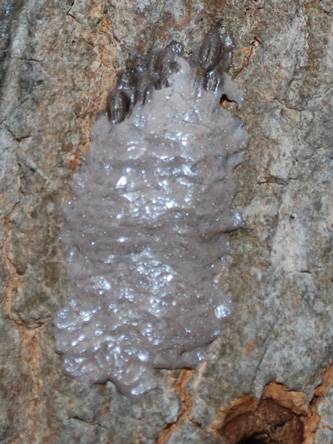
Spotted lanternfly management will vary based on whether the insect is found inside or outside existing quarantine areas. To date, several towns in Pennsylvania including District, Earl, Hereford, Pike, Rockland and Washington and the boroughs of Bally and Bechtelsville are under quarantine. Quarantine areas may expand if the spotted lanternfly is found elsewhere in the US.
Within quarantine areas:
Egg sacs should be scraped off the host surface, soaked in alcohol or hand sanitizer and thrown away.
Origin & Distribution | Identification | Biology | Impacts | Control | New York Distribution Map
The spring ephemeral lesser celandine (Ficaria verna, previously Ranunculus ficaria L.), also called fig buttercup, is an herbaceous perennial found throughout the northeastern United States. It prefers moist, sandy soil, and thrives along stream and river banks, in open forested flood plains, and in other wetland sites. It will grow in drier habitats, however, and as a garden escape can often be found in urban and semi-urban areas.

Native to Europe, Asia and northern Africa, lesser celandine was likely introduced as an ornamental plant. The earliest herbarium specimen dates to 1867 from Pennsylvania. Lesser celandine has been reported throughout the northeastern United States and west to Missouri, and in the Pacific Northwest.
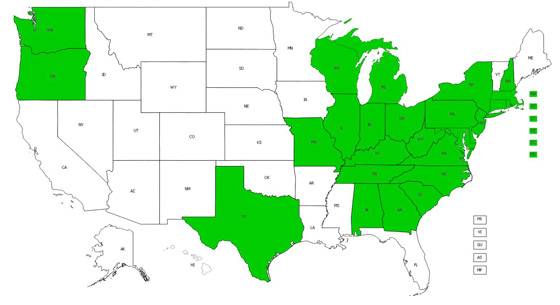
Lesser celandine is low growing and mat-forming, with long stalked leaved densely arranged in a basal rosette. Mature rosettes can reach up to 30 cm (12 in) diameter and up to 30 cm (12 in) tall. The kidney shaped leaves are 4 to 9 cm (1.6 to 3.5 in) wide, smooth, and have wavy edges. Leaf stalks (petioles) are deeply grooved and U-shaped in cross section. Flowers are yellow, 2 to 6 cm (0.8 to 2.4 in) wide and have long (10 to 30 cm; 4 to 12 in) peduncles. There are five sub-species of lesser celandine, distinguished largely by reproductive characters. Ornamental varieties may have a range of flower colors.
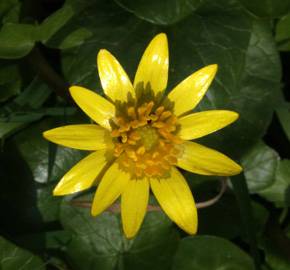
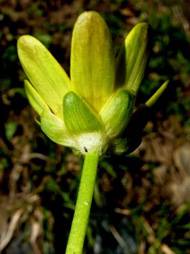
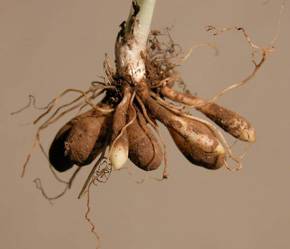
Lesser celandine is ephemeral (short-lived), and its emergence is triggered by increased light availability in the early spring. Shoots emerge from late-March to mid-April depending on environmental conditions, and flowering, which may be linked to water availability, occurs from late April to mid-May. Some sub-species produce pale aerial bulbils in the leaf axils. Seed production occurs in late spring, and by summer the above ground vegetation dies back and the plant becomes dormant. Seeds do not mature on the plant; rather, they require an after-ripening period to fully mature. Some varieties do not produce many viable seeds, and the aerial bulbils and tuberous roots are the primary mode of reproduction. Bulbils are dispersed through animal and environmental disturbance, and can be carried along waterways.
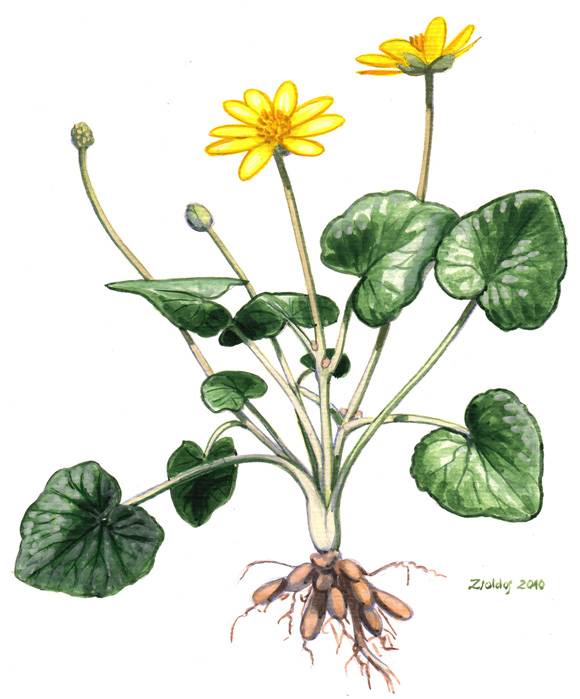
Lesser celandine emerges earlier than most native plants, and may inhibit the development and reproduction of other spring ephemerals, particularly smaller species like spring beauties (Claytonia spp.), trilliums (Trillium spp.), and bloodroot (Sanguinaria canadensis). These native wildflowers are a source of nectar for bees and other insects in the early spring. The bare ground left behind after lesser celandine senesces in late spring may be colonized by other weedy species.
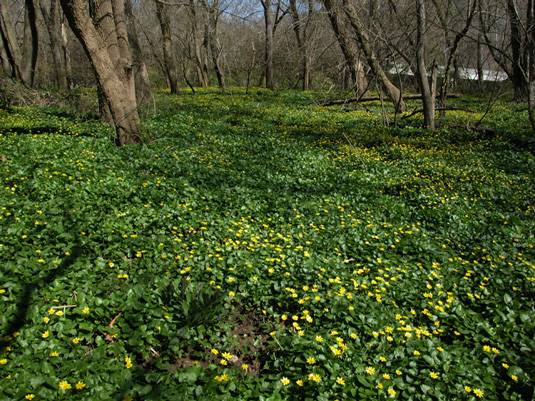
Due to its ephemeral nature and capacity for vegetative reproduction, lesser celandine can be challenging to effectively control. Small infestations can be removed manually, though care must be taken to completely remove the tubers from the soil. Repeated, early season mowing may reduce or stay growth of lesser celandine, but risks dispersing aerial bulbils. Glyphosate based herbicides may also be effective, and will require far less soil disturbance than manual removal. A 1.5% concentration of a 39% to 41% glyphosate isopropyl-amine salt solution with a non-ionic surfactant is effective for spot applications. Herbicide is most effective when applied early in the season and, when possible, applications should be made before any non-target plants have emerged. Note: Always check state/provincial and local regulations for the most up-to-date information regarding permits for control methods. Follow all label instructions. Mention of chemicals in this profile does not represent a recommendation by NY Sea Grant or Cornell University.
This map shows confirmed observations (green points) submitted to the NYS Invasive Species Database. Absence of data does not necessarily mean absence of the species at that site, but that it has not been reported there. For more information, please visit iMapInvasives.
Introduction | Biology and Habitat | Identification | Similar Species | Ecological Impacts | Control | New York Distribution Map
Wineberry (Rubus phoenicolasius) is an invasive shrub in the same genus as raspberries and blackberries. Wineberry creates spiny, inpenetrable thickets that reduce an area’s value for wildlife habitat and recreation. It was introduced to North America in the 1890s as breeding stock for raspberries. It was found invading natural areas by the 1970s, and it is currently recorded in most states east of the Mississippi River and in Alabama (USDA PLANTS Database). Wineberry replaces native vegetation, including native edible berry shrubs. It is differentiated from other berry-producing canes by the reddish appearance of its stems (caused by a dense coat of red hairs), silvery underleaf surfaces, and bright red berries. Management can be obtained through mechanical, chemical, or combination of control methods.
|
|
|
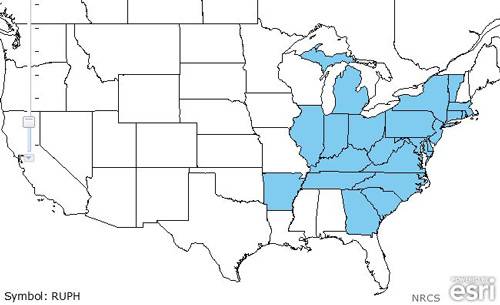
Wineberry is a close relative of other raspberries and blackberries. It grows in long shoots called canes up to six feet long, which can re-root at the tips when they touch the ground. Wineberry canes grow in two stages; in the first year they form a vegetative cane, and in the second year the cane becomes woody and produces lateral branches, flowers, and fruit (technically drupes, an aggregation of single seeded drupelets, but for clarity the term fruit will be used). Wineberries are perennial; while the canes each live two years, the plant produces new canes every year. Leaves are produced in April, flowers in May, and fruit from late June to August; leaves drop in late November. Wineberry does not need pollen from another individual to set seed, and therefore may reproduce more easily than natives like saw-toothed blackberry (Foss 2005).
Wineberry has a wide range of tolerance for light, soil type, and moisture level, and is hardy to USDA Zone 5 (annual minimum temperatures to -20F). While it is most productive in edge and wasteland habitats, it can be found in most habitats that exist in New York (Innes 2009), including forested habitats. Wineberry seeds are spread by animals, and seeds dropped on the forest floor can germinate when falling trees provide light to the forest floor. Once established, wineberry can persist indefinitely and reproduce once further disturbance occurs (Innis, 2005).
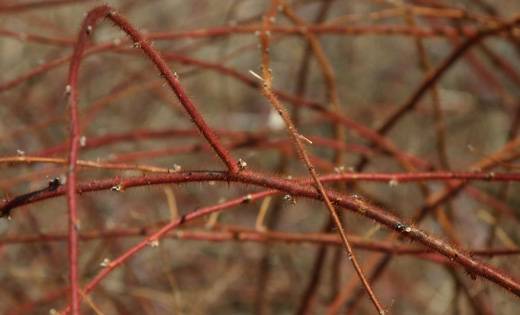
Wineberry is related to other raspberries and blackberries, and shares characteristics of both. Like raspberries, wineberry has silvery underleaves, a fruit core that remains on the stem when the ripe fruit is picked, and thorns. It is differentiated from other raspberry species by the fine red hairs that grow densely on its stems (and flowers) causing a reddish hue to the plant. Wineberry fruit is vibrantly red when ripe, which helps differentiate it from native black raspberries and blackberries; it also has three leaflets per leaf rather than five, which separates it from many blackberry species. Unique to wineberry is its small, greenish, hairy flowers with white petals and the way its fruit remain covered by sepals (greenish petal-like structures) until almost ripe.
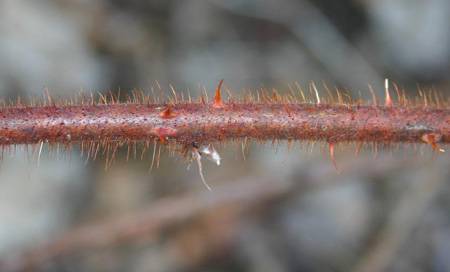
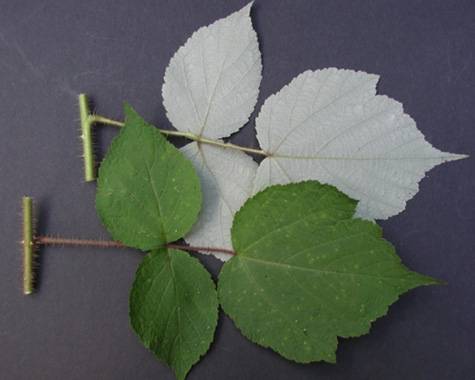
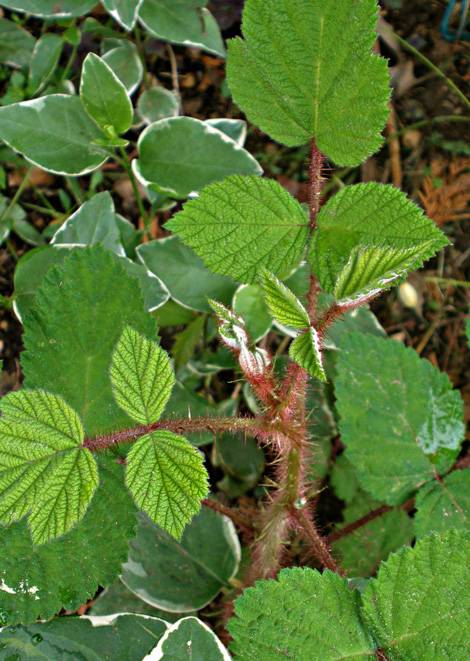
There is quite a range of native and introduced Rubus species in New York; the wikibook Flora of New York has an excellent, easy to navigate identification website which includes wineberry. The more common species easily confused with wineberry are shown below. For a more complete look at the Rubus genus, the Flora of Michigan has an excellent online key.
Rubus odoratus (purple-flowering raspberry or thimbleberry) has maple-shaped leaves that are soft and hairy; leaves not silvery; flowers pinkish-purple. Fruit is flatter and fuzzier than a raspberry, forming more of a cup shape.
Black raspberry (Rubus occidentalis) has whitish underleaves, but flowers hold their white petals out from the center of the flower, and fruit are usually purple-black (occasionally golden). Stems are green with a bluish cast that rubs off and have sparse, fairly robust thorns. Canes tip-root.
Red raspberries (Rubus idaeus, Rubus strigosus and many hybrids) have whitish underleaves and white petals, with red fruit, like wineberries. Stems are not covered in red hairs, are more lightly armed than black raspberry, and lack the bluish-white cast on their stems. Flowers might have a few hairs, but are not densely hairy like those of wineberry.
|
|
New York has several species of native blackberries, all of which have green rather than silvery underleaves and solid-cored fruit (mostly black when ripe). Some have five to seven leaflets. Identification to species can be difficult. While the skin on some species is reddish or purplish, none are covered in reddish hairs like wineberry, and many are heavily armored with thorns.
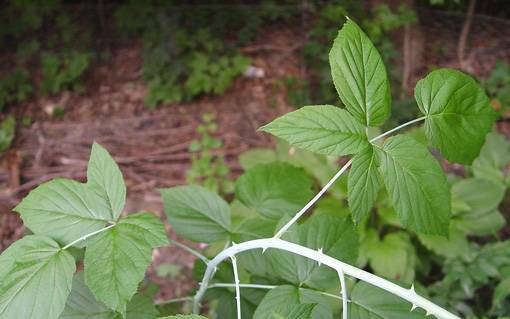
Evergreen blackberry (Rubus laciniatus) is an invasive blackberry. It has highly dissected leaves and black fruit with a solid core.
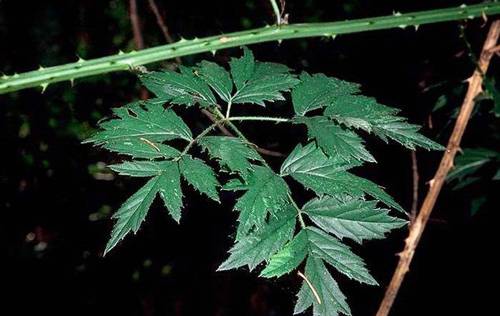
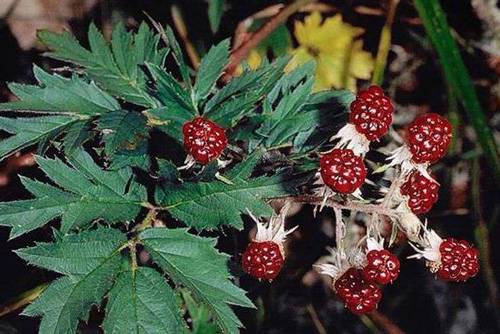
Himalayan blackberry (Rubus armeniacus) is also an invasive blackberry. It has stout, heavily armed but not hairy stems that grow up to 20 feet, tip roots like wineberry does, and produced large, sweet, dark-purple to black solid-cored fruit. It is the only blackberry with a whitish or grey-green underleaf, but usually has five leaflets instead of three, which along with its pinkish-white flowers and black fruit differentiate it from wineberry.
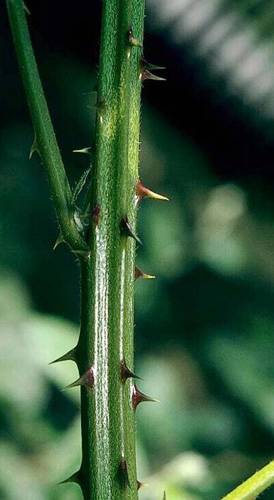
Wineberry can form dense, impenetrable thickets in natural areas, making the habitat unusable for some species and creating hiding places for others. It is more aggressive than many of the native raspberry and blackberry species, and has a wider range of tolerance for light, soil type, and moisture. Its establishment in forest understories as disturbance occurs can lead to its spread even in mature forests. There has been no study to date documenting its specific impact on native species.
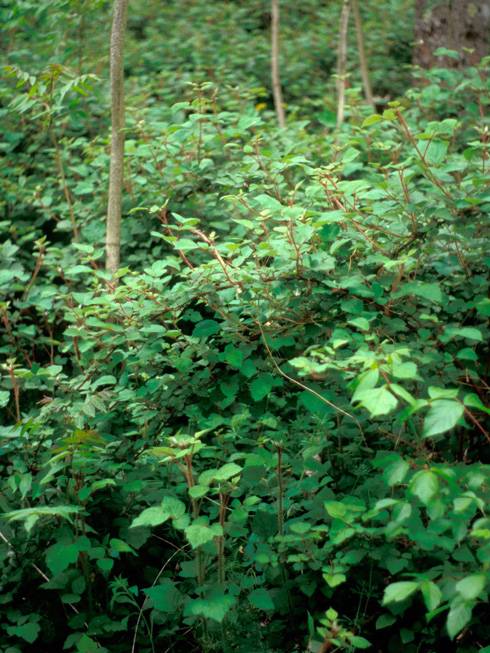
Wineberry control is more straightforward than control of many other invasive plants in New York. While any root fragments may start a new plant, wineberry does not have a vigorous underground storage structure; this makes it easier to control than, for instance, Japanese knotweed or lesser celandine. It is also susceptible to common pesticides.
For any invasive species control project, it is important to have a plan for the location before control begins. Disturbance without replanting often results in the return of either the same invasive species or other invasives to the site; have a restoration plan in place before starting invasive species removal.
Mechanical control
Hand pulling wineberry or digging with a spading fork can be a successful strategy in small patches or where repeat visits are not costly, particularly if native species are planted where the ground has been disturbed. Return visits for a few years will be necessary to remove new plants that sprout from root fragments. As wineberry is armed with thorns and hairs, minimizing exposed skin during mechanical control is advisable.
Chemical control
Wineberry can be controlled using systemic herbicides such as glyphosate or triclopyr (Bargeron et. al., 2003). When using pesticides, be aware that many pesticides are prohibited within 100’ of water, as they are toxic to aquatic life and/or fail to break down in water. Some formulations of glyphosate-based herbicides are permitted for use near water, but the most common formulation (Roundup) is not permitted for use near water due to an adjuvant (chemical that helps the glyphosate stick to plant surfaces) that is toxic in aquatic habitats. Triclopyr also has both aquatic-permitted and prohibited formulations; choose carefully based on the characteristics of your treatment area. Always follow instructions on the label of any pesticide, and remember that New York has its own regulations for pesticides, both for the entire state and for specific regions like Long Island that have special environmental considerations. For New York State regulations, visit the DEC website: http://www.dec.ny.gov/regulations/8527.html.
Foliar application and cut-stump application are both recommended in various fact sheets (Massachusetts Audubon, Innes 2009, bugwoodwiki), but no experiments have been published on the relative efficacy of pesticides or application methods on wineberry (2015).
This map shows confirmed observations (green points) submitted to the NYS Invasive Species Database. Absence of data does not necessarily mean absence of the species at that site, but that it has not been reported there. For more information, please visit iMapInvasives.
Range & Distribution | ID & Biology | Hosts & Habitat | Impacts | Prevention & Control
The giant African land snail (Lissachatina fulica, formerly Achatina fulica) was originally introduced to Hawaii in 1936 and Florida in 1966. Florida’s original eradication campaign took ten years and cost one million dollars. The snail was rediscovered in 2011. Eradication efforts are ongoing (2015).
Giant African land snails are eaten in many countries and sold as canned pet food for skinks, turtles, monitors, and small animals.
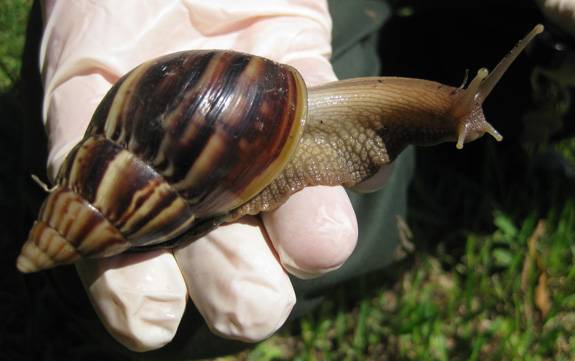
Giant African land snails are native to East Africa and found in Asia. In the USA, in Southern Florida and Hawaii, the snails are under quarantine. The USDA APHIS (Animal and Plant Health Inspection Service) has established additional regulated areas in Florida (June 2015). The snails are sold and raised as pets in other countries, including those of Europe. While not yet in New York, the giant African land snail, owing to the illegal pet trade, is prohibited in the state.
One of the largest terrestrial snails, full-grown adults can reach almost 8 inches (20 cm) long and 5 inches (13 cm) in diameter. Adult shells are brownish with darker brown lengthwise stripes, have seven to nine whorls including a swollen long body whorl, and covers at least half the length of the snail. Snails have female and male reproductive organs. One mating can result in multiple clutches of eggs over time. Rapid population increases are likely because each snail can produce 1,200 eggs per year.
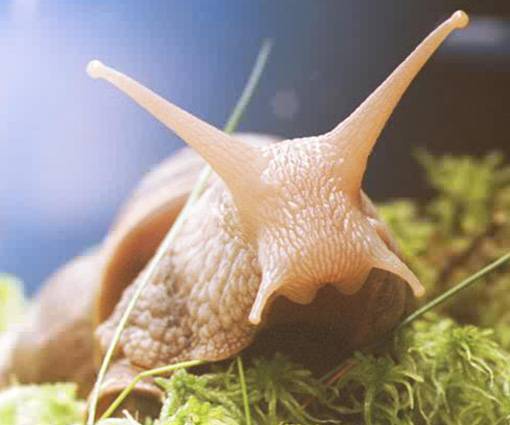
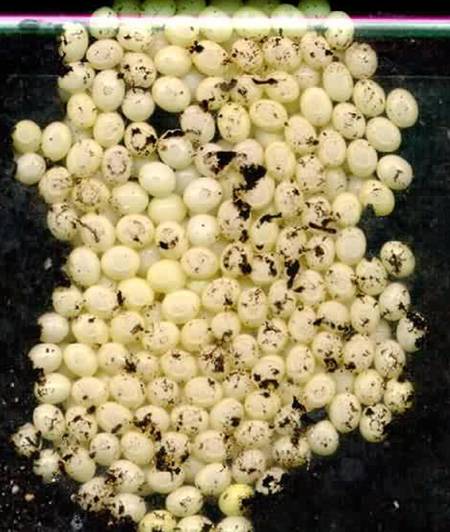
The snails are found in many plant habitats and are known to preferentially consume beans, peas, cucumbers, melons, and peanuts. Also at risk are ornamental plants, tree bark, and even the plaster, stucco, or paint on buildings.
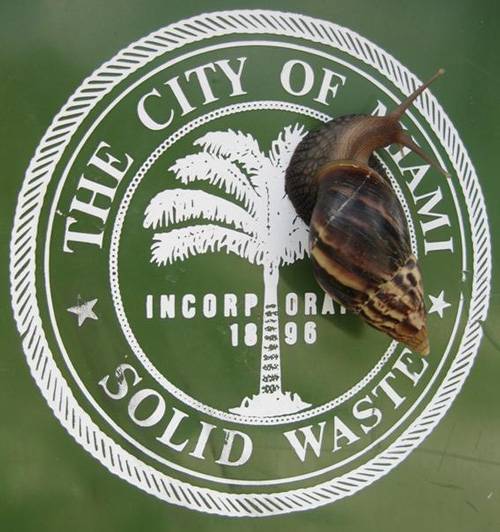
Because of their large size, ability to consume over 500 different kinds of plants, and cause damage to plaster and stucco buildings, the giant African land snail is one of the most damaging snails in the world. The snails are also a potential risk to human health because they can carry a parasitic nematode that can cause meningitis.
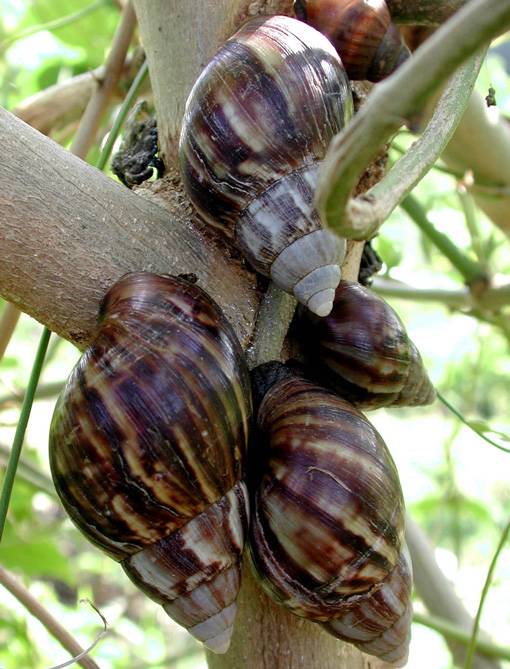
Giant African land snails are able to survive cold temperatures in a semi-hibernation state. They represent a potential threat to New York even though they thrive in tropical/subtropical areas. If a snail shell is larger than two inches (5-6 cm) it is most likely a type of giant snail. Do not handle with bare hands. Importation is prohibited and specimens will be confiscated by customs. Do not purchase as pets or as educational animals through foreign online dealers or local distributors. For safe removal, or if found outdoors or for sale, contact local New York Department of Environmental Conservation, Cornell Cooperative Extension, or USDA offices.
Distribution | ID & Biology | Hosts & Habitats | Impacts | Prevention & Control
The walnut twig beetle, Pityophthorus juglandis, is a tiny Scolytid bark beetle native to the southwestern US. It is the insect vector of Thousand Cankers Disease. The disease, first observed in the 1990s but not recognized until 2008, has killed many walnut trees planted outside their native range across the western US. It is now a serious threat to walnuts in their native eastern range.
The walnut twig beetle was first detected in the Eastern US in 2010 and has now been found in Tennessee, Virginia, Pennsylvania, North Carolina, Ohio, and Maryland. It is widespread across Western US. While not yet in New York, the walnut twig beetle has been confirmed in adjacent states and poses a threat to walnuts in New York, the Northeast and New England.
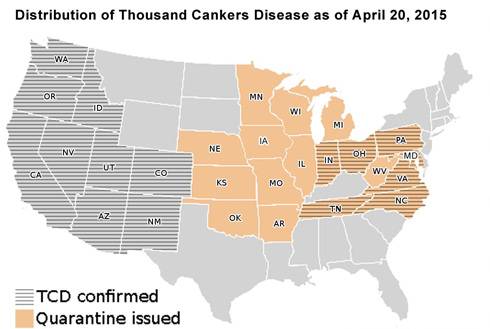
The walnut twig beetle is reddish brown to brown and only 1.5-2mm long. Identification of this tiny bark beetle is possible with a dissecting microscope but confirmation by an expert is recommended because there are many similar species. A very good identification guide is “LaBonte and Rabaglia, A Screening Aid for the Identification of the Walnut Twig Beetle, Pityophthorus juglandis Blackman.” The fungus is carried into the tree on the bodies of adult beetles; the beetles bore under the bark, create tunnels or galleries, and lay their eggs.
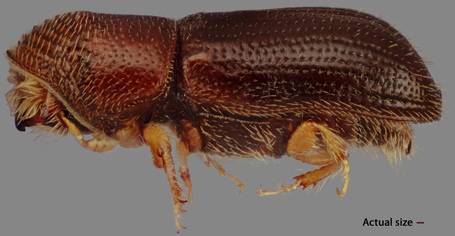
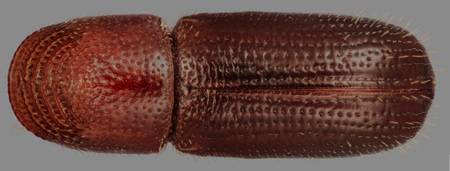
All walnut species tested so far are susceptible, particularly black walnut but also the Northern and Southern California black walnut species.
Thousand Cankers Disease, caused by a fungus and spread by the walnut twig beetle, is usually lethal to walnut trees (Juglans spp), particularly black walnuts (Juglans nigra), within a few years of noticeable symptoms. Black walnut has high economic value for wood production. Throughout its native range, the net volume of black walnut growing stock on timber land was valued at over $500 billion.
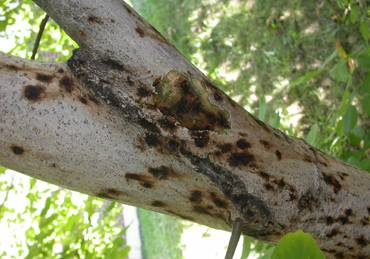
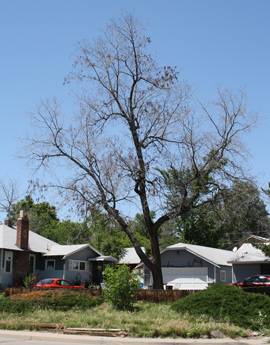
Prevention through quarantine is key because symptoms (thinning canopy, leaf yellowing/wilt, tip die-back) appear after it is too late to save infected trees or nearby trees. Most eastern states where the disease has been detected have adopted quarantines on the movement of nursery walnuts and walnut wood. Maps of range and quarantine information can be found here.
Heat treatment of logs before movement for processing has been shown to be an effective way to prevent spread of both the disease and beetle.
Pheromone baited traps have been developed for beetle detection in new areas but are only effective at short range.
Identification | Look-alikes | Biology & Habitat | Prevention and Control | New York Distribution Map
Japanese virgin’s bower (Clematis terniflora DC, also called sweet autumn clematis) is an invasive ornamental vine in the Clematis genus. It is widely planted in gardens for its profusion of small, showy white flowers in late summer and equally showy silvery, corkscrew, feathery seedheads. Given support it can reach 30’ in height. Its prolific nature and aggressive growth make it a problem in natural areas, where it can smother mature trees and displace native vegetation. Japanese virgin’s bower is on New York State’s regulated species list; it can be transported, purchased, sold and planted, but it can only be planted where it will not threaten natural areas, and must be displayed for sale with signs explaining that it is an invasive species.
Japanese virgin’s bower is native to Japan and China. It was brought to North America as an ornamental species. Leaves are opposite and compound, with three to five heart-shaped leaflets 2-3½” long; the surfaces are dark green and shiny, paler on the undersides. It climbs using tendril-like petioles to cling to support. Flowers are about 1” across, white, four-petaled, and held in clusters of 3-15; the plant blooms in late summer to fall. Seeds are small and brown, with showy, silvery-grey, feathery, curving seedheads.
Japanese virgin’s bower looks like many other Clematis genus species; the closest match is a native plant also commonly called virgin’s bower, Clematis virginiana. Flowers and seeds are similar between the two species, but leaves of C. virginiana are toothed and lobed as opposed to C. terniflora’s entire, ovate leaves. The other Clematis have larger flowers of various colors; these ornamental species and hybrids are not particularly aggressive.
Japanese virgin’s bower can survive a wide range of soil types and light availability, although it is most productive with shade on its roots and full sun on its foliage. It establishes in hedgerows, waste spaces, roadsides, stream banks and forest edges. It is a semi-woody perennial, producing foliage on new stems each year. In southern climates it is semi-evergreen. Japanese virgin’s bower produces shoots from last year’s woody stems in spring. It flowers in August and produces seeds by late September, which are dispersed by wind.
Cultural: The similar native virgin’s bower, Clematis virginiana, has many of the same ornamental characteristics as Japanese virgin’s bower and is less aggressive. They are so similar they are sometimes sold interchangeably at nurseries. Planting a native or noninvasive alternative will reduce the chances of this invasive damaging nearby natural areas.
Monitoring: Japanese virgin’s bower is most easily seen in the late summer, when it produces a froth of white flowers. Otherwise, look for a vine with small, oval- to heart-shaped, opposite leaves. There is currently no research on control of this species; all information is from gardening and extension sources.
Manual and Mechanical Control: Remove the plants and its roots. Some root fragments may resprout, so repeat visits may be necessary. Given the plant’s prolific nature, expect seeds still in the soil to continue to sprout new plants for some time. Research on the longevity of C. terniflora’s seeds in the soil is not available.
Biological Controls: Currently there are no biological controls for Japanese virgin’s bower.
Chemical Controls: Japanese virgin’s bower responds to control with glyphosate and triclopyr and other common broadleaf herbicides, with no known resistance issues. However, all will require repeat treatments (Langeland and Meisenburg, 2009). Before using chemical controls, always check with your state’s environmental regulatory agency to check on the legality of using any particular chemical.
This map shows confirmed observations (green points) submitted to the NYS Invasive Species Database. Absence of data does not necessarily mean absence of the species at that site, but that it has not been reported there. For more information, please visit iMapInvasives.
Origin and Expansion | Biology | Description | Impacts | Control | New York Distribution Map
Commonly grown and transplanted for its showy yellow flowers, yellow flag iris (Iris pseudacorus) has invaded wetlands and other aquatic and semi-aquatic habitats. Yellow flag can be found at the edges of streams and ponds, in open and forested flood plains, along shorelines, and in freshwater and brackish marshes.
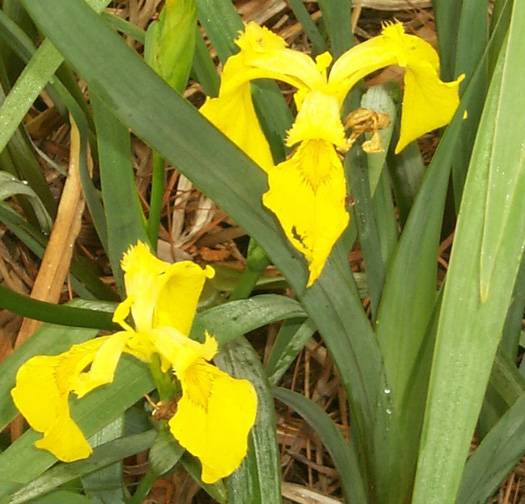
Yellow flag is native to temperate regions of Europe, Asia, and northern Africa. It was imported to North America as an ornamental plant as early as the late-1700s. The plant has since been deliberately propagated as a horticultural plant and for erosion control and in sewage treatment ponds. It is now present in all but four states.
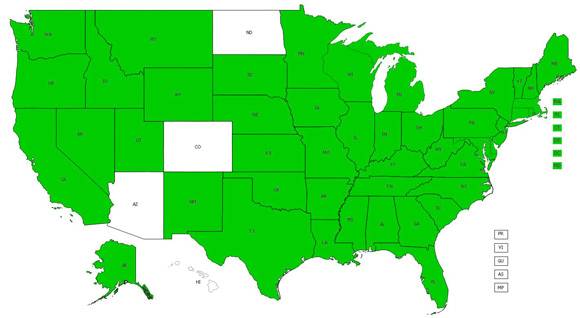
Yellow flag is a perennial. Shoot emergence and most seedling germination occur in spring, though in mild winters shoots may survive and remain green throughout the year. Flowering begins by late-May and continues into early-July. Plants generally do not flower until the third year of growth. Flowers are pollinated by bees and a few species of long-tongued flies. Seed production occurs from August through October; each plant can produce several hundred seeds. Seeds are mainly dispersed by currents, containing an air pocket to help keep them afloat, and are capable of remaining afloat for more than a year. Seedlings germinate and establish best in moist but not waterlogged soil. Yellow flag expands through rhizome growth. The thick rhizomes can persist for over ten years in the soil and can survive for more than three months if dried. The rhizomes of old plants older than ten years often break into fragments, which may then be dispersed by water.
The sword-like leaves are flat, erect and linear with a raised midrib. The dark to blue-green blades are 25-90 cm long and have sharply pointed tips. The flowering stems are usually similar in size to the leaves (50-100 cm in length). Flowers are pale to bright yellow or cream colored and 7-9 cm wide. The large (4-8 cm) seed pod is 3-sided and angular and turns from glossy green to brown as it ripens. Each pod contains dozens of seeds densely arranged in 3 rows. Roots are 10-30 cm in length, and the fleshy rhizomes are 1-4 cm in diameter.
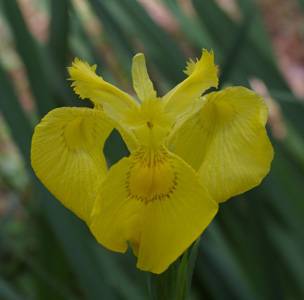
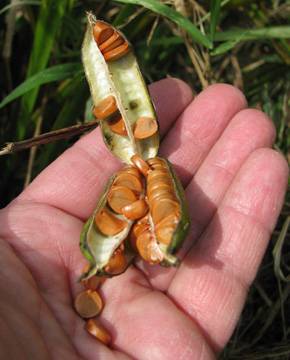
Yellow flag expands quickly via rhizomes, and can form dense monotypic stands that can replace and crowd out valuable aquatic plants like cattails and other, native, irises. The root system forms a dense mat which compacts soil and inhibits seed germination of other plants. Large yellow iris populations may also reduce the habitat available to native fish and waterfowl. Thick growths of yellow flag can clog irrigation systems and streams and, by trapping sediment in the roots, can narrow waterways. All parts of the plant are toxic to livestock and other animals.
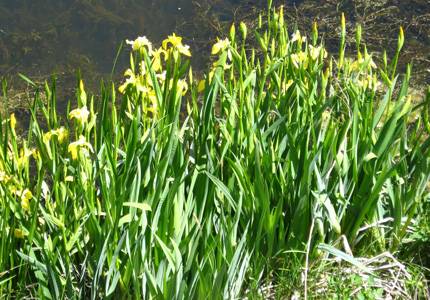
Small clumps can be dug out, though this is only effective if the rhizomes are entirely removed. Mowed plants will regenerate from the rhizomes, so plants must be cut multiple times to exhaust their energy reserves. The sap may cause skin irritation, so gloves should be worn when handling cut or otherwise damaged stems. Glyphosate herbicides approved for aquatic use can be effective, particularly if applied to recently cut foliage and stems. No biological control agents have been released to control yellow flag. [Note: Always check state/provincial and local regulations for the most up-to-date information regarding permits for control methods. Follow all label instructions.]
This map shows confirmed observations (green points) submitted to the NYS Invasive Species Database. Absence of data does not necessarily mean absence of the species at that site, but that it has not been reported there. For more information, please visit iMapInvasives.